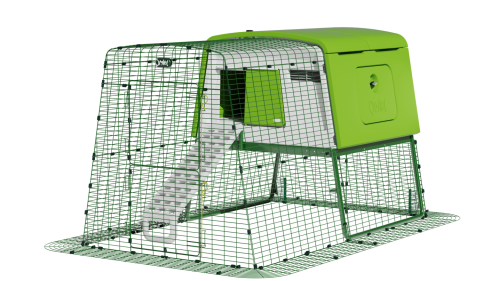Chickens are creatures of habit, and that’s an advantage if you want to train them. They are unable to learn tricks like a parrot, or become obedient like a dog, but there are certain learning curves you and your hens can take together.

Chickens sometimes need examining - a trained hen makes this easy
Teaching Hens To Return To The Coop
If you think this sounds tricky, think again. Let a puppy off lead, and he’ll run away after the first moving object he sees. Open a budgie cage before the bird is trained and you’ll have a tricky time luring your pet back inside. Chickens are different.
All you have to do is keep the hens in their coop - somewhere that caters for all their needs, such as an Eglu coop and run - for a week to ten days after they have been installed. The coop is now etched on their brain as home. Open up in the morning, and they will come and go at will, but will always return to the safety of the coop in the evening.
So, in this case, ‘training’ has involved nothing more than keeping the hens indoors for a week. If you want them to return indoors before evening, you can use the tips in the section below...
Training Hens To Come When You Call
To get chickens running when you call, use food. Scatter some treats in the run when the hens are installed, and either shout something like “Greedy girls!”, or use a whistle, bell, small gong - whatever you fancy (as long as it’s not too loud: you don’t want to scare them off!). They will soon come to associate the call with the food.
This technique is very useful if you want to lure a hen onto a set of scales for weighing, or if you need to call a chicken who appears to be injured or ill. Call or whistle as usual, and the birds will come flapping your way eagerly - including the injured one, if she is able. You can then gently pick her up and see what the problem is.

Training chickens for easy handling
Herding Chickens
To make free-ranging hens move in the direction you want them to, stand behind the flock and clap your hands, then move slowly towards them, with your arms stretched out to each side, to make you appear wider and more of a barrier. The hens will group together and move as a herd.
If you have a dog with some herding ancestry - any of the sheepdog breeds, or crosses - you could train him or her to help with the herding too.
Target Training Your Chickens
A target trainer is a stick with a ball or disk on the end. You can buy them online, or can make one yourself using a stick with something attached to the end.
The goal is to train your hen so that she moves to wherever you place the training stick. Once again the secret weapon is food.
Position the stick somewhere in the run, holding onto the end. When a hen comes to investigate - as they are endlessly curious animals - offer a treat. After you’ve done this a few times, the hen will move towards the training stick as soon as she sees it.
If you call her name at the same time, it will reinforce the association of the sound and the treat (and will also convince your audience that your pet hen comes when you call her name!)
In time, the hen will begin to follow the stick too, so you can lead her around the garden.
Training A Chicken To Perch on You
This isn’t something everyone hankers after… however, it is possible to hand-train a hen.
Start by offering food on your upturned palm at ground level - something nice and visible like a bunch of dandelion leaves, for example. The hen will eventually come across for a peck. Use a clicker (of the type usually used with dog training) to reinforce the learning. Some breeds are more shy than others, so be gentle and patient.
Once the hen is happily walking to your hand and feeding, you can up the stakes. Begin raising the hand, giving a familiar click of the pet clicker, until eventually the hen has to flap up to perch on you so that she can reach the food.
You can eventually raise things to shoulder level - if you really want to!




Comments
There are no comments just yet